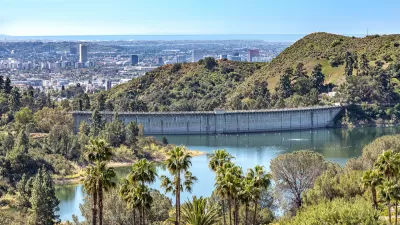During this “super year” of storms, L.A. County has successfully captured 96 billion gallons of stormwater which is enough to meet the needs of about 2.4 million people a year.

Los Angeles County has managed to capture and store a significant amount of stormwater brought forth by heavy rains this winter and spring which sent torrential flows down local creeks and rivers. Specifically, an estimated 295,000 acre-feet of water since last October or 96.3 billion gallons was captured. This is sufficient to meet the water needs of approximately 2.4 million people a year, which is almost one-fourth of the county’s population of ten million residents.
As reported by Ian James, the county, working in coordination and collaboration with the Los Angeles Department of Water and Power and other agencies, was able to capture and store this amount of water thanks in part to investments totaling over $1 billion since 2001. Some of the funding has been used to raise dams and increase the capacity of spreading grounds, where water is sent into basins and then percolates underground into aquifers.
The county has also spent more than $1 billion since 2001 to remove sediment from reservoirs to ensure their water-catching capacity is not limited or diminished. A large portion of the funds have come from the L.A. County Flood Control District, which receives revenues through property taxes. Funding for stormwater-catching infrastructure is also generated through the Safe, Clean Water Program, which was established after county voters passed Measure W in 2018.
Though the amount of runoff captured since October has been substantial, the county’s facilities took in more water during the major storms over the previous 12 months — an estimated 626,000 acre-feet, which is enough to supply about five million residents for a year.
To learn more, please read the source article.
FULL STORY: L.A. County captures 96 billion gallons of water during ‘super year’ of storms

Alabama: Trump Terminates Settlements for Black Communities Harmed By Raw Sewage
Trump deemed the landmark civil rights agreement “illegal DEI and environmental justice policy.”

Planetizen Federal Action Tracker
A weekly monitor of how Trump’s orders and actions are impacting planners and planning in America.

Why Should We Subsidize Public Transportation?
Many public transit agencies face financial stress due to rising costs, declining fare revenue, and declining subsidies. Transit advocates must provide a strong business case for increasing public transit funding.

Understanding Road Diets
An explainer from Momentum highlights the advantages of reducing vehicle lanes in favor of more bike, transit, and pedestrian infrastructure.

New California Law Regulates Warehouse Pollution
A new law tightens building and emissions regulations for large distribution warehouses to mitigate air pollution and traffic in surrounding communities.

Phoenix Announces Opening Date for Light Rail Extension
The South Central extension will connect South Phoenix to downtown and other major hubs starting on June 7.
Urban Design for Planners 1: Software Tools
This six-course series explores essential urban design concepts using open source software and equips planners with the tools they need to participate fully in the urban design process.
Planning for Universal Design
Learn the tools for implementing Universal Design in planning regulations.
Caltrans
Smith Gee Studio
Institute for Housing and Urban Development Studies (IHS)
City of Grandview
Harvard GSD Executive Education
Toledo-Lucas County Plan Commissions
Salt Lake City
NYU Wagner Graduate School of Public Service





























